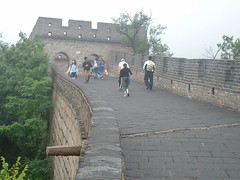Wednesday, December 06, 2006
10,000 watch towers, 4,000 miles: the Great Wall
The Great Wall of China ( Wànlǐ Chángchéng; literally "The long wall of 10,000 Li (里)¹") is a Chinese fortification built from the 5th century BC until the beginning of the 17th century, in order to protect the various dynasties from raids by Hunnic, Mongol, Turkic, and other nomadic tribes coming from areas in modern-day Mongolia and Manchuria.
Several walls, also referred to as the Great Wall of China, were built since the 5th century BC, the most famous being the one built between 220 BC and 200 BC by the first Emperor of China, Qin Shi Huang.
- The Great Wall is the world's largest man-made structure.
- 6,352 km (3,948 miles)
- Along most of its arc, it roughly delineates the border between North China and Inner Mongolia.
- 10,000 watch towers (which were used to store weapons, house troops, and send smoke signals),
- each tower has unique and restricted stairways and entries to confuse attackers.
Seen from outer space?
In fact, the Great Wall is only a few meters wide - similar in size to highways and airport runways - and is about the same color as the soil surrounding it. It cannot be seen by the unaided eye from the distance of the moon, much less from Mars. If the Great Wall were visible from the moon, it would be easy to see from near-Earth orbit, but from near-Earth orbit it is barely visible, and only under nearly perfect conditions; it is no more conspicuous than many other manmade objects.
- Communication between the army units along the length of the Great Wall, including the ability to call reinforcements and warn garrisons of enemy movements, was of high importance.
- Signal towers were built upon hill tops or other high points along the wall for their visibility.

